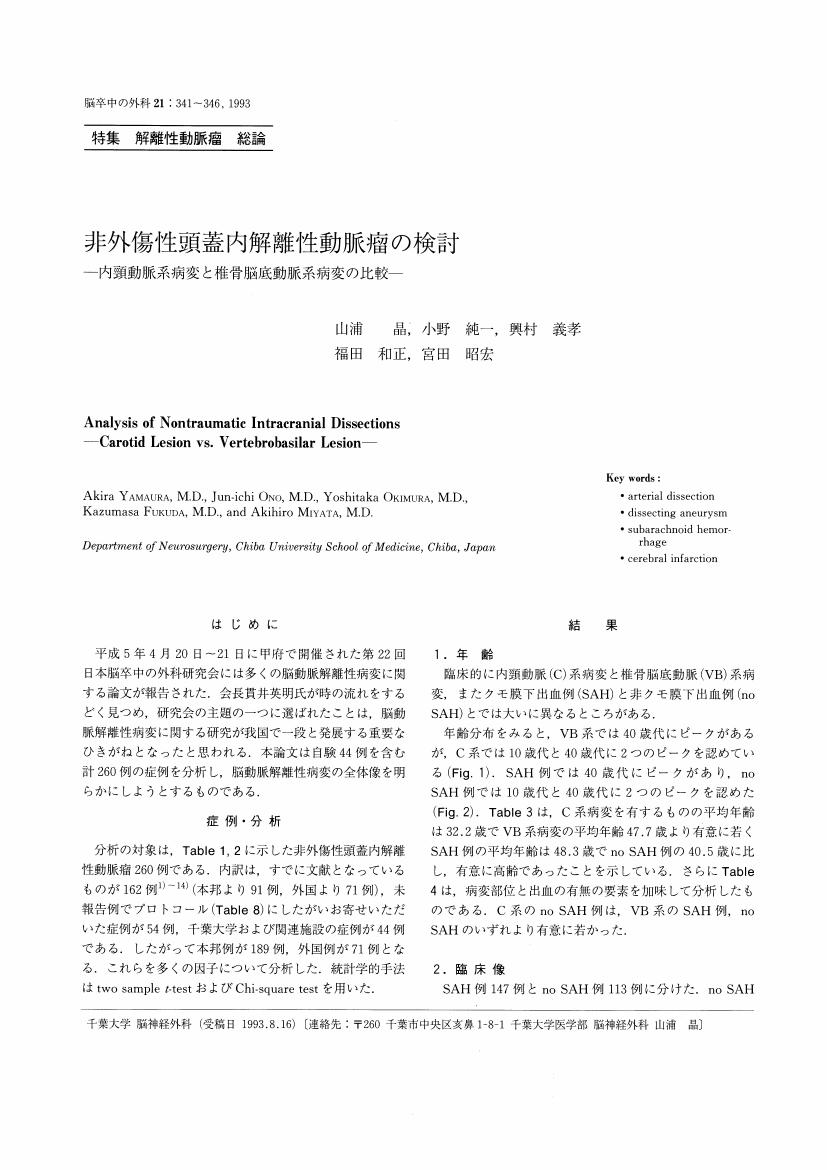1 0 0 0 OA 多血性側脳室三角部髄膜腫に対する術前塞栓術の 1 例
- 著者
- 西野 航 山内 利宏 安藤 亮 松浦 威一郎 橋本 憲一郎 鈴木 浩二 相川 光広 古口 徳雄 宮田 昭宏
- 出版者
- 特定非営利活動法人 日本脳神経血管内治療学会
- 雑誌
- 脳血管内治療 (ISSN:24239119)
- 巻号頁・発行日
- vol.6, no.4, pp.181-188, 2021 (Released:2021-12-20)
- 参考文献数
- 10
【目的】多血性側脳室三角部髄膜腫に対する摘出術前塞栓術を行った 1 小児例の経験から,この部位の髄膜種に対する塞栓術の戦略を検討した.【症例】13 歳女児.主訴は左麻痺.術前塞栓を施行せず行った初回摘出術は,わずかな摘出にとどまった.後大脳動脈皮質枝からの栄養動脈を液体塞栓物質で塞栓した 2 回目の摘出術は,塞栓で壊死した後方 2/3 を摘出した.2 年後に再増大し,後脈絡叢動脈からの栄養動脈を同様に塞栓し,腫瘍を全摘出した.【結論】脈絡叢動脈の終末血管によって構成されていた側脳室三角部髄膜腫に対し,液体塞栓物質を圧入せずに栄養動脈の近位部閉塞のみで十分に塞栓効果を得ることができた 1 例を経験した.
1 0 0 0 OA 非外傷性頭蓋内解離性動脈瘤の検討 -内頸動脈系病変と椎骨脳底動脈系病変の比較-
1 0 0 0 OA 高齢者重症くも膜下出血の急性期治療
- 著者
- 小林 繁樹 古口 徳雄 大石 博通 和田 政則 宮田 昭宏 中村 弘 八木下 敏志行
- 出版者
- 一般社団法人 日本脳卒中の外科学会
- 雑誌
- 脳卒中の外科 (ISSN:09145508)
- 巻号頁・発行日
- vol.34, no.2, pp.79-85, 2006 (Released:2008-08-08)
- 参考文献数
- 17
- 被引用文献数
- 4 3
We evaluate the effect of introduction of endovascular treatment with Guglielmi detachable coils (GDC) on the outcome of aged patients (>=70 years old) with subarachnoid hemorrhage (SAH). Between 1990 and 2003, 92 aged patients with SAH underwent angiography as candidates for early aggressive treatment in our hospital. In 1990-96 (Group 1), treatment options were early craniotomy surgery, intensively delayed craniotomy surgery and conservative management (n=38), while GDC embolization at an acute stage was added to those 3 treatment options in 1997-2003 (Group 2, n=54). We compared clinical courses and outcomes assessed by Glasgow Outcome Scale (GOS) at discharge between the 2 groups. The percentage of the patients in whom the aneurysm was occluded at an acute stage (early-treated cases) significantly increased from 47% in Group 1 to 76% in Group 2. In the early-treated cases in Group 2, GDC embolization was chosen as the treatment option in 69% of all cases (Grade I-V) and 78% of poor-graded cases (Grade IV-V). The percentage of favorable outcomes (good recovery and moderately disabled in GOS at discharge) significantly increased from 34% in Group 1 to 63% in Group 2 for all cases, and from 53% to 78% for early-treated cases. None of the poor-graded patients had a favorable outcome in Group 1, while 24% did in Group 2. In the early-treated cases in Group 2, the percentage of favorable outcomes did not differ significantly between the aged (>=70 y) and younger patients ( The introduction of GDC embolization expanded the indication of early treatment for aged patients with poor grade and, as a consequence, improved the outcome of those patients.
1 0 0 0 OA くも膜下出血重症例に対する急性期治療
- 著者
- 小林 繁樹 佐藤 章 古口 徳雄 水流 京子 和田 政則 宮田 昭宏 中村 宏 渡辺 義郎 八木下 敏志行
- 出版者
- 一般社団法人 日本脳卒中の外科学会
- 雑誌
- 脳卒中の外科 (ISSN:09145508)
- 巻号頁・発行日
- vol.32, no.1, pp.13-18, 2004 (Released:2007-06-12)
- 参考文献数
- 14
- 被引用文献数
- 6 7
Indication of early treatment remains controversial for patients in poor clinical condition (Hunt & Kosnik Grade 4 or 5) after subarachnoid hemorrhage (SAH). Since 1997, we have adopted endovascular treatment using Guglielmi detachable coil (GDC) as a treatment option for these patients. In this study, we compared clinical courses of the cases treated in 1990-1996 to those treated in 1997-2002 to evaluate the efficacy of changes in treatment strategy. Between 1990 and 2002, 130 cases with SAH in Grade 4 and 5 underwent angiography as candidates of early aggressive treatment in our hospital. For the 63 cases in 1990-96 (Group 1), treatment options were early and intensively delayed craniotomy surgery and conservative management, while for the 67 cases in 1997-2002 (Group 2), GDC embolization at acute stage was added to these 3 treatment options. We compared the 2 groups of patients in terms of clinical courses and outcomes, assessed with Glasgow Outcome Scale Score (GOS) at discharge. The percentage of the patients in which aneurysm was occluded at acute stage increased from 67% in Group 1 to 87% in Group 2 for Grade 4 and from 33% to 52% for Grade 5. In Group 2, 44% of Grade 4 and 83% of Grade 5 patients were treated by GDC embolization. The outcomes of the cases in both Grade 4 and 5 were better in Group 2 than in Group 1. That is, for Grade 4 cases, the percentage of Good Recovery (GR) significantly increased from 7% in Group 1 to 27% in Group 2. And for Grade 5 cases, good outcome (GR or MD) increased from 5% in Group 1 to 18% in Group 2. Two patients recovered completely from Grade 5 in Group 2, both of which were treated with GDC while none in Group 1 recovered completely from Grade 5. The incidence of symptomatic vasospasm was not changed between Group 1 (20%) and Group 2 (16%). The introduction of GDC embolization extended the indication of early treatment for severe SAH patients because it was less invasive and, as a consequence, improved the outcome of those patients.
